Borneo is wild, diverse, and absolutely fascinating. The island impresses with breathtaking nature, incredible biodiversity, and exciting cultural highlights. Whether you hike through dense rainforests, observe proboscis monkeys and orangutans in the wild, or explore the impressive cave systems and coral reefs – Borneo is an adventure you won’t soon forget. In this article, we’ll take you along and show you the most beautiful sights in Borneo that the Malaysian part has to offer. Enjoy browsing!
- General information about Borneo
- Sights in the state of Sandakan
- Sights in the state of Sabah
- Hotel tips for Borneo
- Transportation on Borneo – Getting from A to B
- Travel tips for Borneo
- Conclusion
General information about Borneo
Borneo is the third largest island in the world and lies in the heart of Southeast Asia. Politically, it belongs to three countries: Malaysia, Indonesia, and Brunei. The Malaysian part, which makes up about 26% of the island’s total area, is divided into the two states of Sabah in the north and Sarawak in the west. Borneo is known for its dense rainforests, majestic mountains, and pristine beaches. Mount Kinabalu in Sabah is the island’s highest peak at 4,095 meters. Large rivers such as the Kinabatangan (Sabah) and the Rajang (Sarawak) are important lifelines and serve as transportation routes for the region. The island has one of the most biodiverse ecosystems in the world. Orangutans, proboscis monkeys, pygmy elephants, and over 15,000 plant species live here. Malaysian Borneo is also home to many indigenous peoples, including the Iban, Kadazan, and Penan. Each community has its own language, culture and traditions.
The most important things in brief:
- Capital: Kota Kinabalu (Sabah) & Kuching (Sarawak)
- Population: approx. 6.7 million
- Languages: Malay (official language), English, Chinese, indigenous languages
- Currency: Malaysian Ringgit (MYR)
- Time zone: MYT (UTC+8) excluding daylight saving time
- Religions: Islam, Buddhism, Christianity, Hinduism

Sights in the State of Sandakan
We start in the southwest of the island with the highlights in Sandakan. Many begin their journey here, as Kuching is easily accessible by plane from, for example, Kuala Lumpur, the Island of Penang, Bangkok, or Singapore. Kuching is also often referred to as the “Gateway to Borneo.”
1. The “Cat City” of Kuching
Kuching is often called the “Cat City” because “Kuching” means cat in Malay. You’ll quickly notice this in the city: cat statues are everywhere, there’s even a cat museum and many souvenirs related to the theme. However, the name itself probably comes from the Chinese word for the river that flows through the city: “Ko Chin.” Nevertheless, the cat symbolism has become firmly established.
Start your exploration at the 2 km long Kuching Waterfront and enjoy a stroll overlooking the Sarawak River and the impressive State Assembly Hall. This is the parliament building of Sarawak, the city’s landmark and hard to miss.
While you’re in Kuching, you should also take a look at the Cat Museum. It’s a fun and, above all, kitschy museum with a pretty wild exhibition of all sorts of things related to cats. If you want to get an insight into the culture and history of the region, you should visit the Sarawak Museum.
In Kuching’s old town, you’ll find plenty of markets (e.g., Waterfront Bazaar and Satok Weekend Market), temples (e.g., Tua Pek Kong Temple), mosques (e.g., the Floating Mosque), cat statues, and street art. The latter is reminiscent of the great street art in George Town on the island of Penang. The work of the orangutans at the end of Indian Street is particularly beautiful (more on that here). Tours of China Town and Little India are also worthwhile.
Popular tours of Kuching:
- Best of Kuching: Half-Day Heritage Bike Tour**
- Sarawak River Sunset Cruise*
- Guided tour of Kuching*
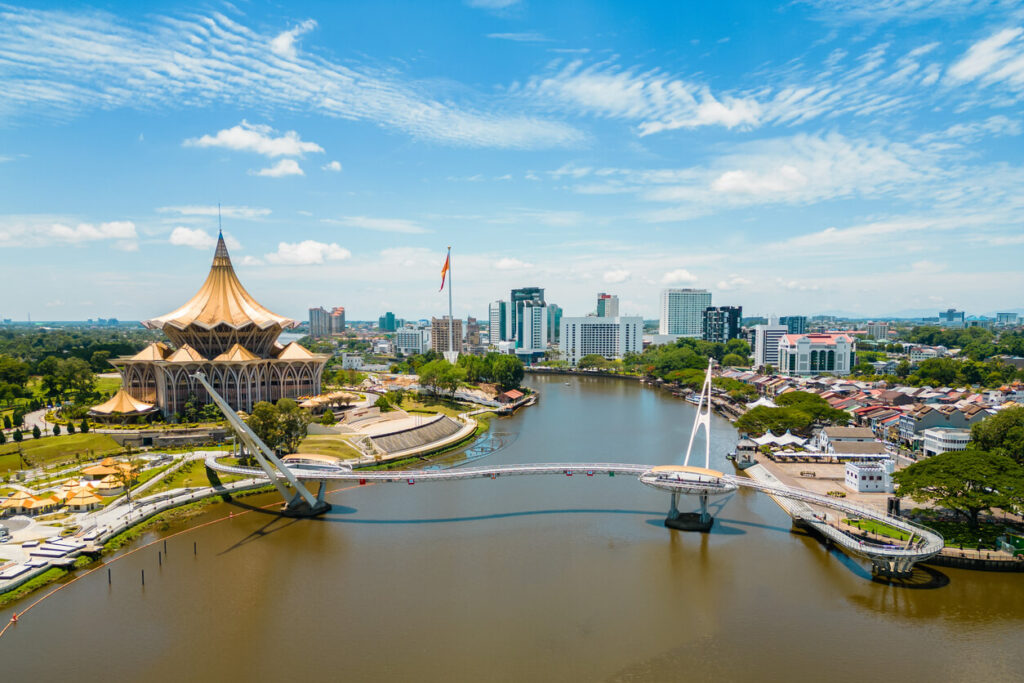
2. Bako National Park
Even more worth seeing than Kuching is the lush surroundings with its many great excursion destinations. For example, there’s Bako National Park, which is only about 37 kilometers from Kuching and is Sarawak’s oldest national park. In this national park, you can experience animals in the wild: proboscis monkeys, long-tailed macaques, silver leaf monkeys, monitor lizards, flying lemurs, and a variety of bird species make the park a paradise for wildlife enthusiasts. Added to this are the impressive landscapes, which combine mangrove forests, rainforest, steep cliffs, and beautiful beaches in a manageable area. The plant diversity is also truly fascinating: carnivorous pitcher plants and tropical flowers grow in abundance here, making the park a great natural highlight in Sarawak. If you enjoy hiking, you’ll find 18 well-marked trails, ranging from easy strolls to challenging routes. The Lintang Loop and the Telok Pandan Kecil Trail are particularly highlights – the latter leads you to a stunning bay with views of the famous sandstone formations. Learn more here: Trails through Bako National Park.
Visitor Information Bako National Park
From Kuching, take a car or bus to the Bako Jetty Terminal (approx. 45 minutes). From there, take a boat (approx. 20 minutes) into the park. The national park offers simple accommodations and a small restaurant. Alternatively, you can stay in Kuching and visit the park as a day trip.
- Address: Muara Tebas Peninsular, 93000, Kuching
- Opening hours: Daily from 8 a.m. to 5 p.m.
- Entrance fee: Adults RM20, children RM7
- Tours: Book a day tour from Kuching here*
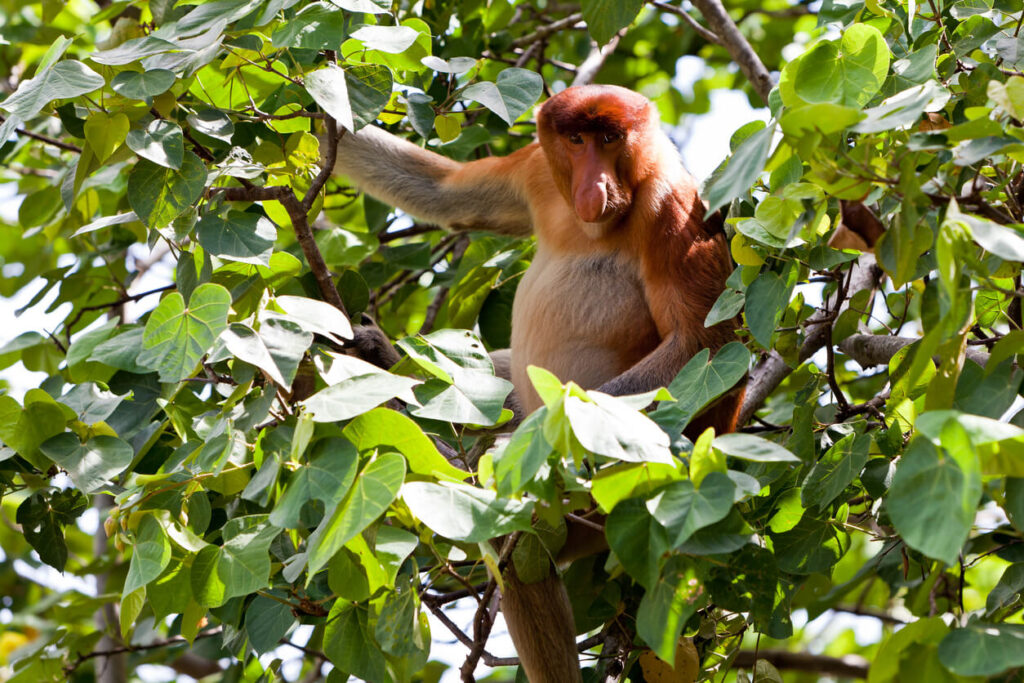
3. Gunung Mulu National Park
Now we’ll take a bigger leap and whisk you away to Gunung Mulu National Park, about 600 km away, which can only be reached by plane. This national park has been a UNESCO World Heritage Site since 2000 and is famous for its gigantic cave systems, spectacular karst landscapes, and pristine rainforests.
Among the top highlights is Deer Cave, one of the world’s largest cave passages, home to millions of bats. Watching their swarms at night is particularly impressive. Clearwater Cave is one of the world’s longest cave systems, featuring an underground river. Lang’s Cave amazes with its stalagmites and stalactites, while Sarawak Chamber is the world’s largest underground cave chamber—large enough to accommodate 40 Boeing 747s.
Away from the caves, the park awaits with a unique blend of dense rainforests and spectacular karst formations. The challenging Mulu Pinnacles Trail leads to the famous, sharp limestone peaks and rewards you with breathtaking views. The park’s wildlife is also impressive – over 3,500 species, including bats, rare insects, and colorful butterflies, make the diversity here particularly special.
Visitor Information Mulu National Park
As already mentioned, you can only reach Gunung Mulu National Park by plane. Small MASwings planes offer flights to Mulu Airport from Miri, Kuching, or Kota Kinabalu. Accommodations on site suit every budget, from simple lodges* to the comfortable Mulu Marriott Resort & Spa*. In addition to the cave tours, you can experience guided jungle hikes, night hikes, and boat trips.
- Address: Mulu, 98070 Sarawak, Malaysia
- Opening hours: Arrival possible at any time of day
- Entrance fees: 5-day pass for adults RM30; children RM10
- Tours: Cave tour, boat trips, tubing, hikes, and much more.
- Brochures & information: More on packing lists, tours & accommodation here
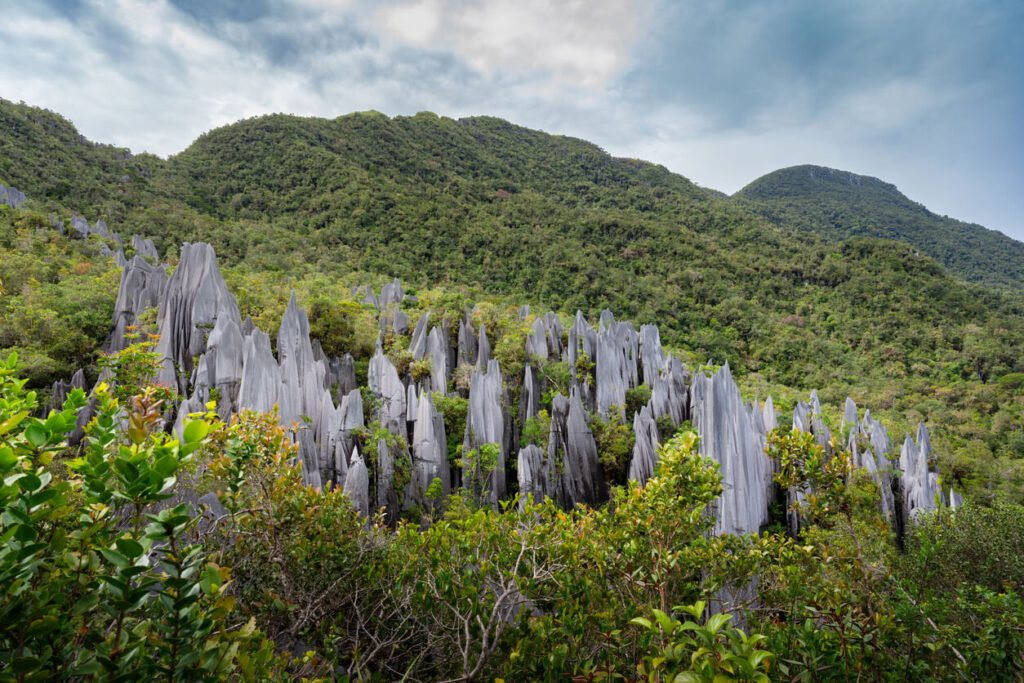
4. Semenggoh Wildlife Rehabilitation Centre
Have you always wanted to experience orangutans in the wild? Here in Borneo, you have a unique opportunity. The Semenggoh Wildlife Rehabilitation Centre in Sarawak is located about 24 kilometers south of Kuching and has been providing a home for injured, orphaned, or orangutans rescued from captivity for almost 50 years.
What’s special about the Semenggoh Centre is that the animals aren’t kept in cages, but live freely in the surrounding rainforest. They are trained for independent lives in the wild, but return regularly for feeding—especially during times when natural food supplies in the forest are scarce. Learn more about the rehabilitation and work of the center, which is actively committed to preserving this endangered species.
Observe these fascinating animals during feedings, which take place twice a day (morning and afternoon). They move freely among the trees. It’s certainly a wonderful experience. But be careful! Sightings cannot be guaranteed. There is plenty of food in the rainforest, so the animals don’t necessarily depend on it for food. From the entrance, it’s a 30-minute hike to the feeding station.
Visitor Information Semenggoh Center:
- Address: KM 20, Borneo Highland Road, 93250 Kuching
- How to get there: Free bus (Metro 103) from Kuching (approx. 1.5 hours) or taxi/rental car
- Opening hours: 8-10 a.m. and 2-4 p.m.
- Feeding times: 9-10 a.m. and 3-4 p.m.
- Entrance fees: Adults RM10, Children RM5 (children under 6 free)
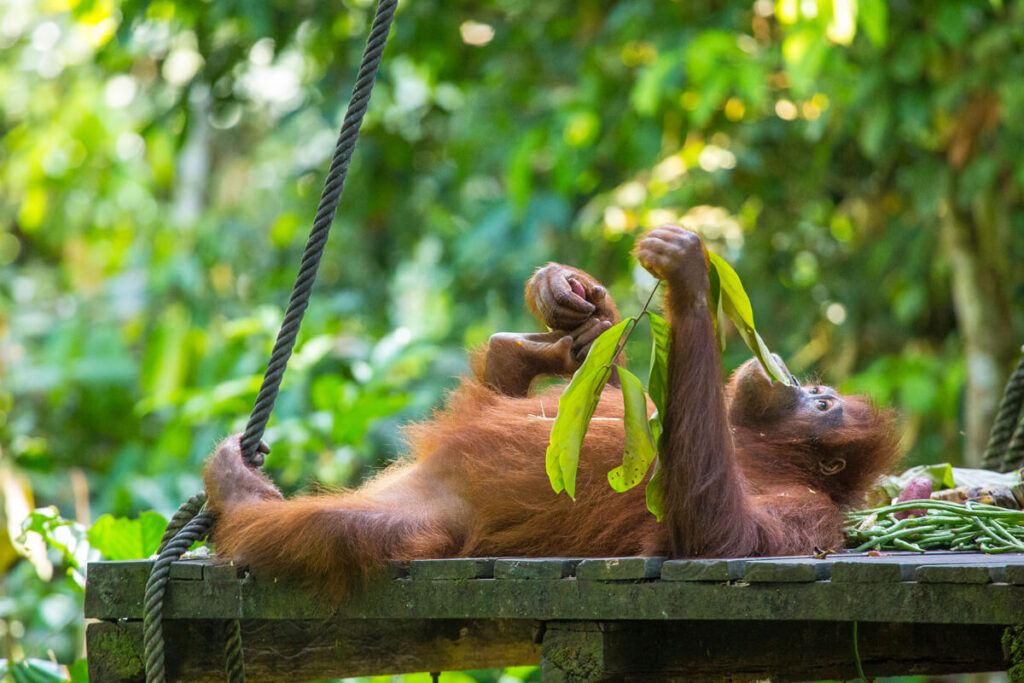
5. Sarawak Cultural Village
The Sarawak Cultural Village is located at the foot of Mount Santubong, about 35 kilometers from Kuching, and offers a vivid insight into the diversity of Sarawak’s cultures. In this “living museum,” you can experience the traditions, architecture, and lifestyles of Borneo’s various indigenous peoples up close.
The village demonstrates the diversity of Sarawak’s cultures in a simple and vivid way. Here, you can visit traditional houses of the Iban, Melanau, and other ethnic groups. In each house, locals in traditional clothing explain their customs and demonstrate dances, music, or handicrafts.
Daily, there are dance and music performances that provide a lively insight into the culture. The complex is situated in a beautiful setting with views of the rainforest and Mount Santubong. A visit can be ideally combined with a detour to Damai Beach.
Visitor Information Sarawak Cultural Village
- Address: Pantai Damai Santubong, Kampung Budaya Sarawak, 93752 Kuching
- How to get there: By taxi or rental car (approx. 45 minutes)
- Opening hours: Daily from 9 a.m. to 5 p.m.
- Admission prices: Adults RM90, children RM57
- Click here for the homepage
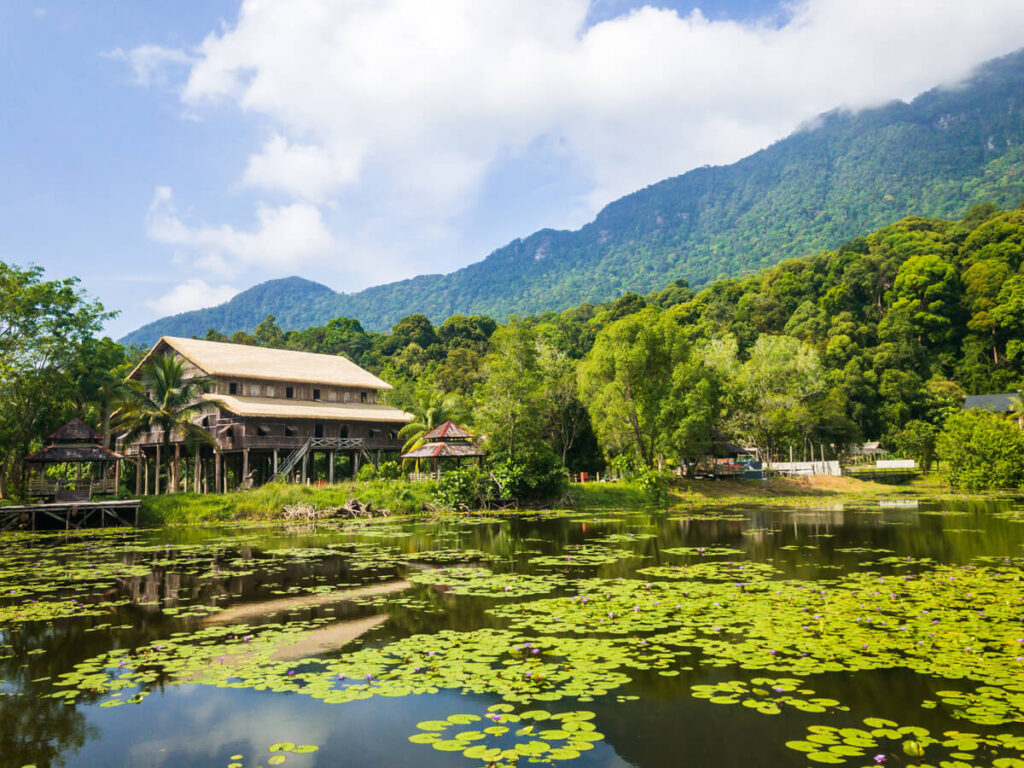
6. Lambir Hills National Park
Lambir Hills National Park is located about 30 kilometers south of Miri. It is known for its exceptional biodiversity and impressive waterfalls nestled amidst dense rainforest. The park is one of the most biologically diverse places in the world, with over 1,200 tree species, numerous orchids, and an abundance of animals such as hornbills, monkeys, and insects.
Some waterfalls are perfect for swimming and relaxing, including the Latak Waterfall, which is just a short walk from the entrance. Dense forests of ancient trees covered in lianas and ferns await you – a great paradise for nature and plant lovers.
Lambir Hills National Park offers a variety of activities: hiking, swimming, birdwatching, photography, night walks, and jungle trekking. At the entrance, you will receive a clear map of the park with all the highlights.
Visitor information for Lambir Hills National Park:
- How to get there: Bus from Miri (journey time: approx. 30-40 minutes)
- Opening hours: Daily from 8 a.m. to 5 p.m.
- Entrance fees: Adults RM20, children RM7
- Accommodation: Chalets & campsites
7. Other highlights in Sarawak
- Niah Caves near Miri
- Gunung Gading National Park
- Batang Ai National Park
Sights in the state of Sabah
Next up are the sights in Sabah, the smaller Malaysian state on Borneo. Sabah also offers a fascinating mix of rainforests, beautiful beaches, and fantastic natural highlights such as Kinabalu National Park and the colorful underwater world of Pulau Sipadan.
1. Kota Kinabalu
Kota Kinabalu has some cool highlights you shouldn’t miss. One worth seeing is the famous Kota Kinabalu City Mosque, also known as the “Floating Mosque,” which is an impressive example of modern Islamic architecture. With space for up to 12,000 worshippers, it is the largest mosque in Kota Kinabalu.
A must-see is also the Kokol Hill Viewpoint, from which you have a fantastic view of the city and the sea – especially at sunset.
For those who enjoy trying fresh fruit, seafood, or street food, a detour to the Gaya Street Sunday Market is worthwhile. If you want to learn more about the culture, religion and history of the region, you should visit the Sabah State Museum.
Other highlights in Kota Kinabalu:
- Masjid Negeri Sabah
- Sri Pasupathinath Alayam (Hindu temple)
- Pu Tuo Si Temple (Buddhist temple)
- Kota Kinabalu Waterfront
- Sabah Tourism Building
- Che Sui Khor Moral Uplifting Society
- Mari Mari Cultural Village (book tour here*)
- Atkinson Clock Tower
- Tanjung Aru Beach
- Bongawan Wetlands (book tour here*)
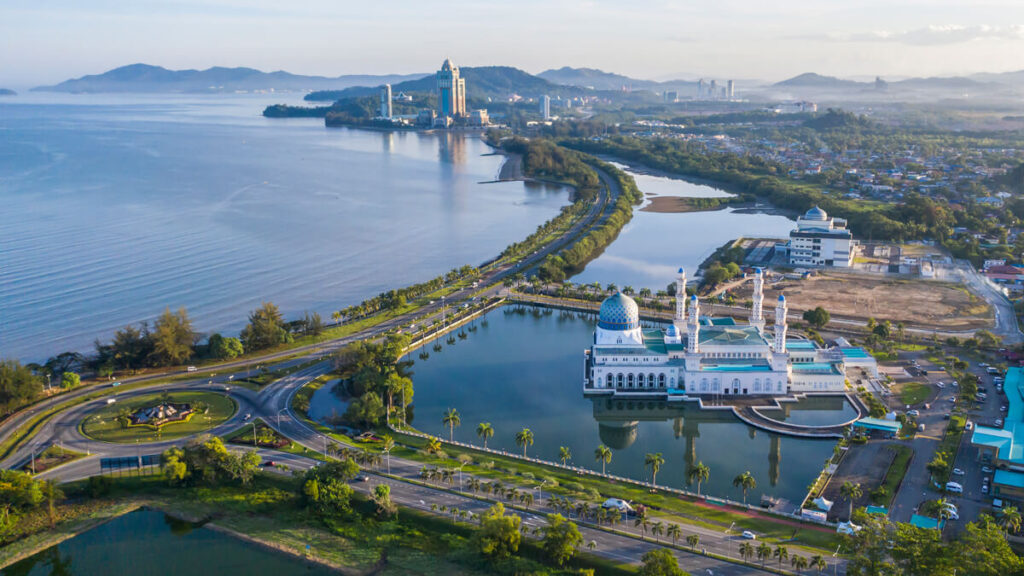 Powered by GetYourGuide
Powered by GetYourGuide
2. Mount Kinabalu
Mount Kinabalu in Sabah on the island of Borneo, at 4,095 meters, is the highest mountain in Southeast Asia outside the Himalayas and is located in Kinabalu National Park, a UNESCO World Heritage Site. The park is known for its impressive biodiversity and is definitely one of the region’s highlights.
For many, climbing Mount Kinabalu is the highlight of their trip. The two-day hike takes you through different climate zones – from dense rainforest to barren alpine landscapes. At the summit, you will be rewarded with a spectacular sunrise and an incomparable view above the clouds rewarded. A mountain guide is mandatory for the climb.
The routes are well-developed, but challenging in places. Since the number of climbers per day is limited, you should plan your tour well in advance. The permit costs RM400 for adults and RM200 for children under 17. Reservations about six months in advance are recommended, but it’s also worth asking about availability at short notice – there are often still some available.
➡️ It’s best to join an organized tour. These usually last one to two days and usually include transfers, meals, etc.:
- Mount Kinabalu 2-Day / 1-Night Tour*
- Mount Kinabalu 3-Day / 2-Night Tour*
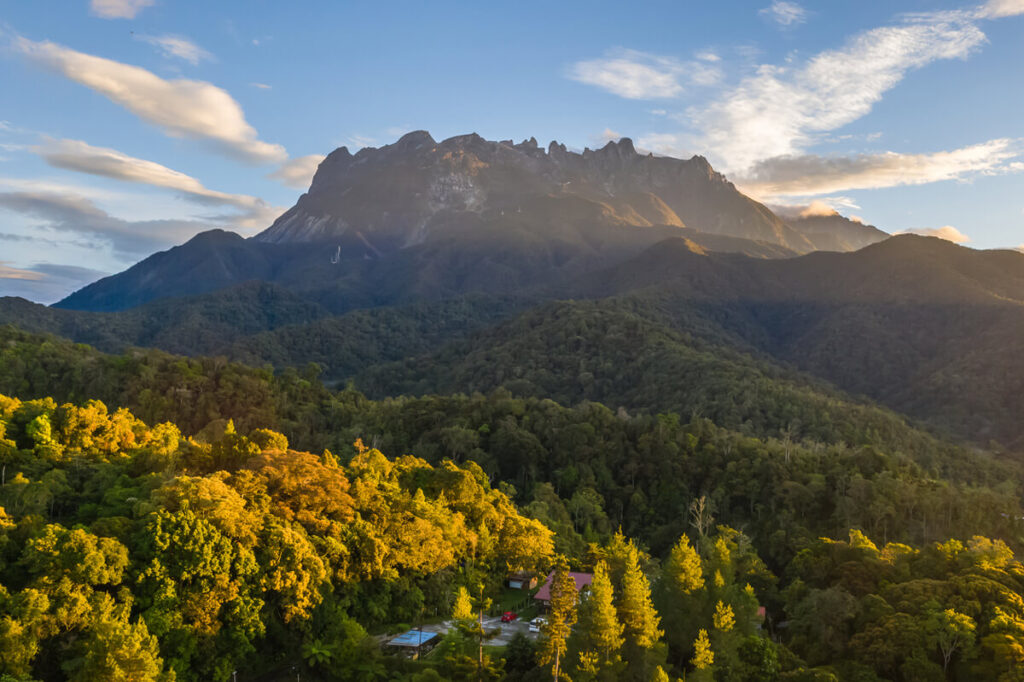
3. Kinabalu National Park
The Kinabalu National Park is one of the most famous attractions in Sabah. As Malaysia’s first national park, it was declared a UNESCO World Heritage Site in 2000 – and not without reason. The park covers an area of 754 square kilometers around the majestic Mount Kinabalu and impresses with an incredible variety of plant and animal species.
The park is particularly known for its botanical treasures: from orchids and rhododendrons to the world-famous Rafflesia, the largest flowers in the world. Numerous bird species, including many endemic ones, make the national park a paradise for nature- and animal lovers.
If you enjoy hiking, Kinabalu National Park is perfect for you. Many well-maintained trails await you there. The paths lead through dense rainforest, past waterfalls, and offer spectacular views of Mount Kinabalu. Prefer something more relaxing? You can take a stroll in the park’s botanical garden (last entry at 3 p.m.) or visit the hot springs in Poring.
Visitor Information Kinabalu National Park:
- Address: 89300 Ranau, Sabah, Malaysia
- Opening Hours: Daily from 8 a.m. to 5 p.m.
- Entrance Fees: Adults RM50, Children RM25
- On-site: Guided tours at 9 a.m., 12 p.m., and 3 p.m.
- Tours: Tour from Kota Kinabalu including Hot Springs & Canopy Walk*
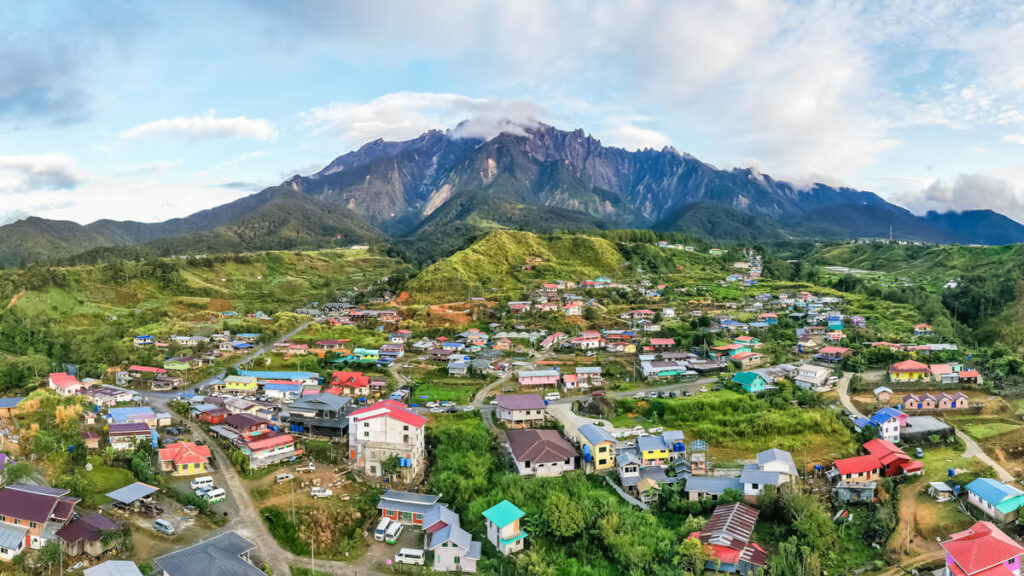
4. Sepilok Orangutan Rehabilitation Centre
The Sepilok Orangutan Rehabilitation Centre in Sabah is one of the most important centers for the protection of the endangered orangutans. Founded in 1964, it provides a home for young, orphaned orangutans and prepares them for release back into the wild.
The centre is located in the heart of the tropical rainforest and is an ideal place to see these impressive great apes. in their natural environment. Feeding times (10 a.m. and 3 p.m.) are particularly exciting, as the animals come to the platforms and you can experience them up close. However, there is no guarantee that you will see the animals!
There is an information center and a guided tour of the sanctuary on site, where you can learn more about the center’s work and the protection of orangutans. In addition to the orangutans, the center also cares for other wild animals, such as the bear cuscus and macaques.
Visitor Information Sepilok Centre:
- Address: WDT 200, Sabah Wildlife Department, Jalan Sepilok, Sepilok
- How to get there: Buses from Sepilok (approx. 45 minutes) and Kota Kinabalu (approx. 5 hours)
- Opening hours: Daily from 9 a.m. to 12 p.m. and 2–4 p.m. (Fridays 9–11 a.m. and 2–4 p.m.)
- Admission prices: Adults RM30, Children RM15
- You can find more information here.
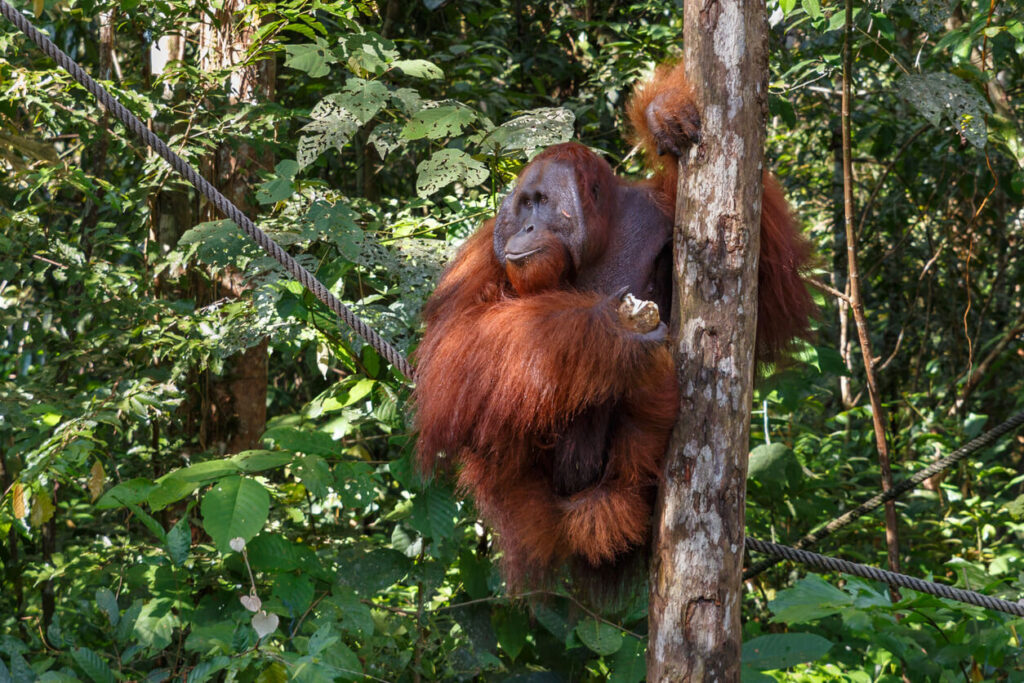
5. Tunku Abdul Rahman Marine Park
The five offshore islands of the 49 km² Tunku Abdul Rahman Marine Park lie just 3 to 8 kilometers off the coast of Kota Kinabalu. The park was designated a national park in 1974 in honor of Malaysia’s first prime minister. The islands Gaya, Sapi, Manukan, Mamutik, and Sulug beckon with stunning sandy beaches, great diving and snorkeling spots, various water sports, and plenty of space to relax.
The largest island, Pulau Gaya, impresses with bright sandy beaches, tropical rainforest, a 20 km network of hiking trails, and a small stilt village right on the sea. Tours depart daily from Jesselton Jetty, allowing you to explore several islands in one day. The crossing takes only 15 to 20 minutes, depending on the island—perfect for a relaxing island trip.
At Jesselton Jetty, you can choose how you want to explore the islands: You can either book a guided tour with a guide, or simply opt for the transfer to the islands and explore them independently. There are various packages depending on how many islands you want to visit—from a single island to four islands. in one day.
Visitor Information TARP:
- How to get there: Boats and tours depart from Jesselton Jetty
- Opening hours: Daily from 8 am to 5 pm (last boat returns at 4 pm)
- Park entrance fees: Adults RM20, children and teenagers RM15
- Transfer prices: 1 island RM35 for adults, children RM30 (more details here)
- Best time to visit: March to September (dry season)
Powered by GetYourGuide 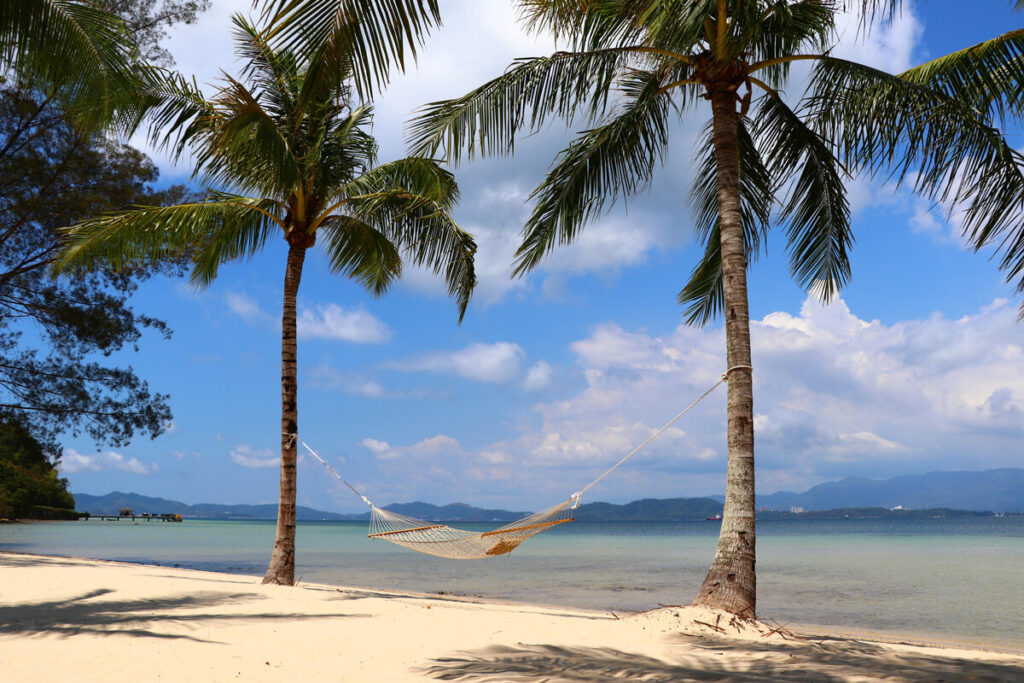
6. Kinabatangan River
The Kinabatangan River flows through a unique landscape in the heart of Borneo. Sabah’s longest river flows through dense rainforests, wetlands, and mangrove swamps, offering one of the region’s most diverse ecosystems. The Kinabatangan is a paradise for wildlife viewing. With a little luck, you might see Bornean pygmy elephants, proboscis monkeys, crocodiles, endangered orangutans, and numerous bird species, including kingfishers and hornbills.
River safaris are particularly popular, allowing you to experience the animals in action in the morning as the forest awakens, or to observe the sunset and the nocturnal wildlife in the evening. Guided jungle walks are also a highlight of the region, where you can learn more about the impressive flora and fauna.
Most tourist accommodations are located in the Region around Sukau. The popular river safaris also depart from there. Minibuses run daily between Sukau and Sandakan. However, the accommodation or tour operator usually organizes the transfer from Sandakan and Sepilok.
Typical daily schedule:
- 6:00 a.m. – Morning river cruise
- 8:30 a.m. – Breakfast
- 11:30 a.m. – Jungle hike
- 1:00 p.m. – Lunch
- 4:00 p.m. – Afternoon river cruise
- 6:00 p.m. – Dinner
- 9:00 p.m. – Night river cruise or jungle hike
Note: In the region around Sukau, palm oil plantations are ubiquitous, often reaching the river. Rainforest deforestation has left clear traces here as well. Already on On the way to Sukau, you will pass seemingly endless plantations. And one more important point: seeing animals during a safari is not guaranteed!
Visitor Information Kinabatangan River:
- Starting Point: Around Sukau and Bilit
- Tours: Day Tour*, 2-Day Adventure*, 3-Day Adventure*,
- Accommodations Sukau: Borneo Nature Lodge*, Sukau Sandipau Stay*, Sukau Greenview B&B*
- Accommodations Bilit: Bilit Adventure Lodge*, The Last Frontier Boutique Resort*
- Best Time to Visit: April – September (July & August = peak season)
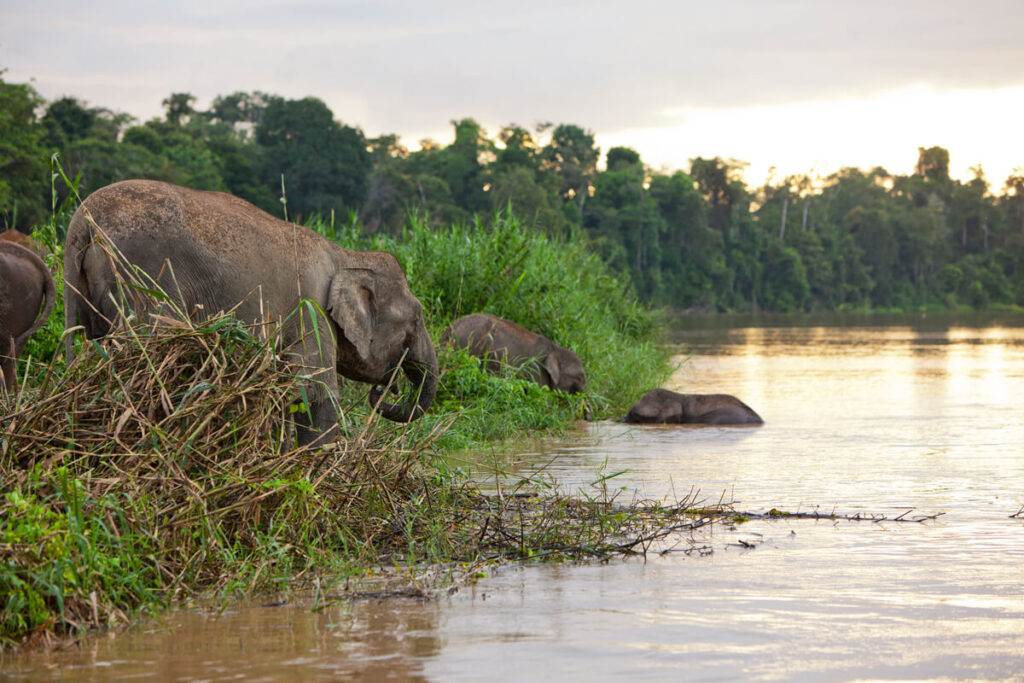
7. Danum Valley
Among the top sights in Borneo is the Danum Valley near Lahad Datu, one of the last large areas of untouched tropical rainforest. Nature and animal lovers will especially enjoy this area. It is located in the east of Sabah and is one of the most biodiverse regions in the world. The 438 km² protected area offers dense vegetation, rivers, waterfalls, and an incredible variety of plants.
The Danum Valley is home to many rare and endangered species, including orangutans, clouded leopards, pygmy elephants, proboscis monkeys, and hornbills. It is one of the few Regions where you can see animals in their natural habitat. There has been neither deforestation nor poaching, so nature has remained largely undisturbed.
You can enjoy various activities on site: guided hikes through the dense rainforest, canopy walks across 300-meter-long suspension bridges, night safaris, or even tubing. Be sure to check in advance which accommodations offer the activities you’re interested in. Not all activities are offered by every accommodation.
Access to this region is only possible for guests staying in local accommodation. This helps control the number of visitors and ensures nature conservation. Self-guided day trips are not permitted, which supports sustainable tourism in the region. You can stay overnight at the Borneo Rainforest Lodge or the Danum Valley Field Centre.
Visitor information Danum Valley:
- How to get to Lahad Datu: Bus from Kota Kinabalu, Sandakan & Tawau or flight from Kota Kinabalu
- Starting point: Drive from Lahad Datu to the Danum Valley Conservation Area (approx. 2 hours)
- Highlights: Sunrise tour, night drive, jungle trekking, tubing, canopy walks
- Tours: You can book various all-inclusive packages here.
- Accommodation: Borneo Rainforest Lodge and Danum Valley Field Centre
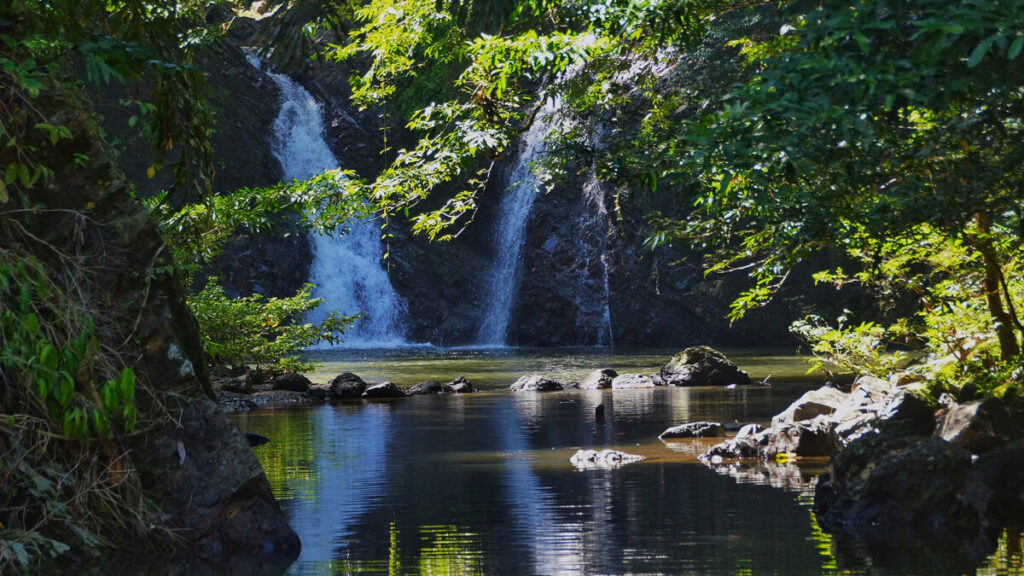
8. Turtle Islands Park
The Turtle Island Park is located about 40 km north of Sandakan in the Sulu Sea and comprises the three islands of Selingan, Gulisan, and Bakungan Kechil. The park covers an area of 1,740 hectares, including the surrounding reefs and marine areas. It was established in 1977 to protect the endangered green and hawksbill sea turtles, which come ashore here at night throughout the year to lay their eggs.
On Pulau Selingan, the only island with visitor accommodation, you have the opportunity to observe the turtles laying their eggs in the evening. Under the guidance of park rangers, you can witness how the eggs are collected and transported to protected breeding grounds. With a little luck, you might also see some freeAccompany newly hatched baby turtles on their way to the sea. A fantastic experience!
The protection of turtles is a top priority on Turtle Island. Visitor activities are strictly regulated (50 people per day) to avoid disturbing the animals. The peak season for turtle watching is between July and October, although turtles come ashore year-round.
The clear waters around the islands are ideal for snorkeling, where you can explore the diverse underwater world and coral reefs. The white sandy beaches offer ideal conditions for sunbathing and relaxing in a tropical setting. Pack a book and enjoy your time on the island. Book your 2-day adventure here*.
Visitor Information Turtle Island Park:
- Arrival: By boat from Sandankan daily around 10 a.m. (journey takes 45–60 minutes)
- Accommodation: Simple accommodations on Pulau Selingan
- Activities: Snorkeling, diving, sunbathing, swimming, turtle watching and egg-laying
- Prices: Adults RM60, Children RM30
- Turtle Nest Adoption Program: RM150 per person
- Best Time to Visit: July – October
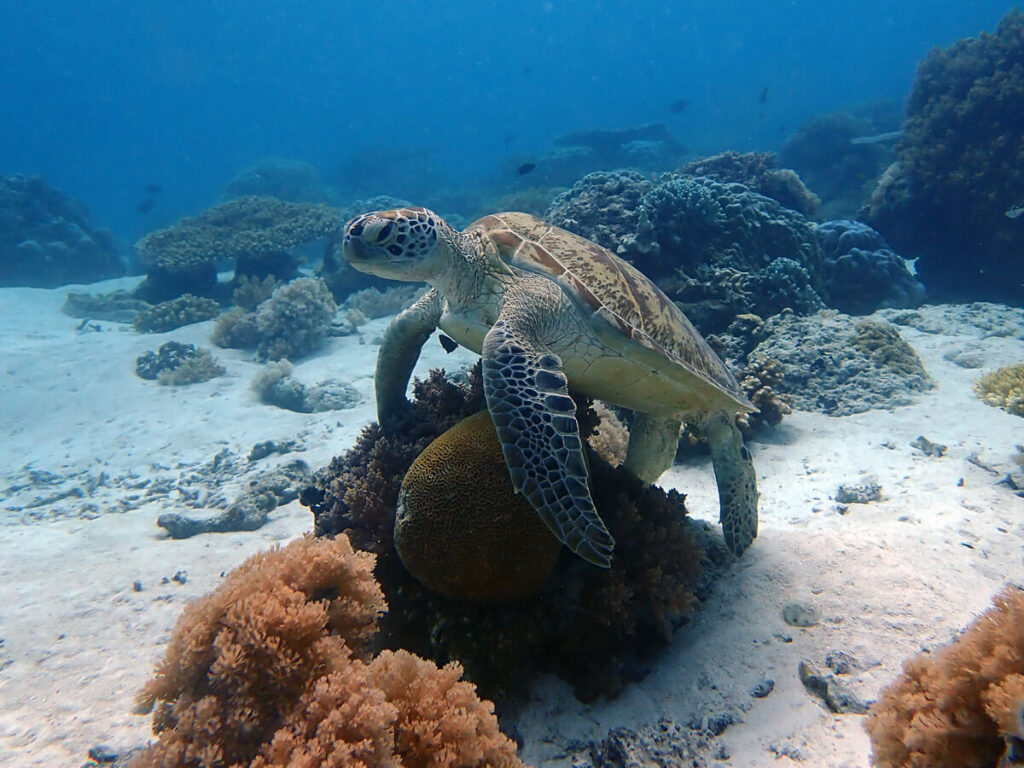
9. Sipadan Island
Sipadan Island (Pulau Sipadan), off the southeast coast of Sabah, is considered one of the best diving destinations in the world. The volcanic island boasts steep coral reefs that reach depths of up to 600 meters and offers an incredible diversity of marine life.
Here, you can expect to see schools of barracuda, reef sharks, sea turtles, manta rays, and, with a bit of luck, even hammerhead sharks. The colorful corals and tiny macro creatures like nudibranchs are also real highlights.
To protect the fragile underwater world, only 176 divers are allowed to visit the island daily. Overnight stays on Sipadan are not permitted. Most people book a room on the nearby Pulau Mabul. There you’ll find not only simple accommodations, but also top-class resorts such as the Mabul Water Bungalows*.
Important note: Please note that not all accommodations can offer permits for Sipadan Island. A minimum stay of 3 to 4 nights is often required to obtain permission for a day of diving. You can find out more about this topic here: Sipadan Island Permits. You don’t need a special permit for the other beautiful islands.
Visitor information for Sipadan Islands:
- Arrival: Flight to Tawau + drive to Semporna + boat to Mabul or Sipadan Island
- Accommodation: Sipadan Kapalai Dive Resort, Borneo Divers Mabul Resort*, Spheredivers Scuba & Leisure*
- Tours: Accommodations organize diving tours and the diving schools themselves.
- Deal: Book a 4-day adventure* (incl. water bungalow, 6 dives, full board & transfer)
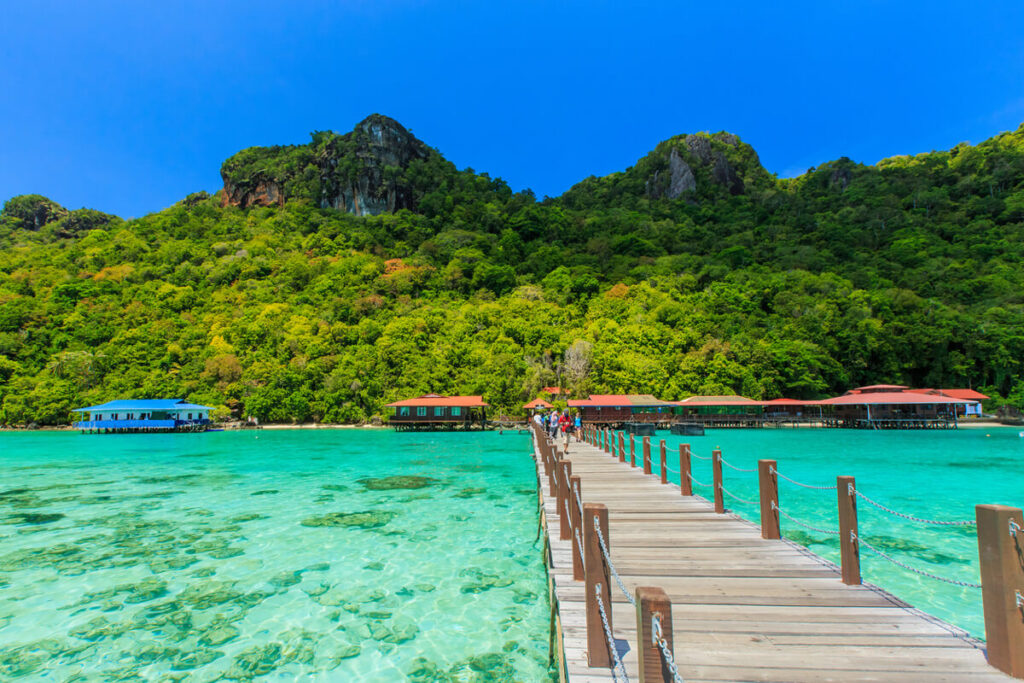
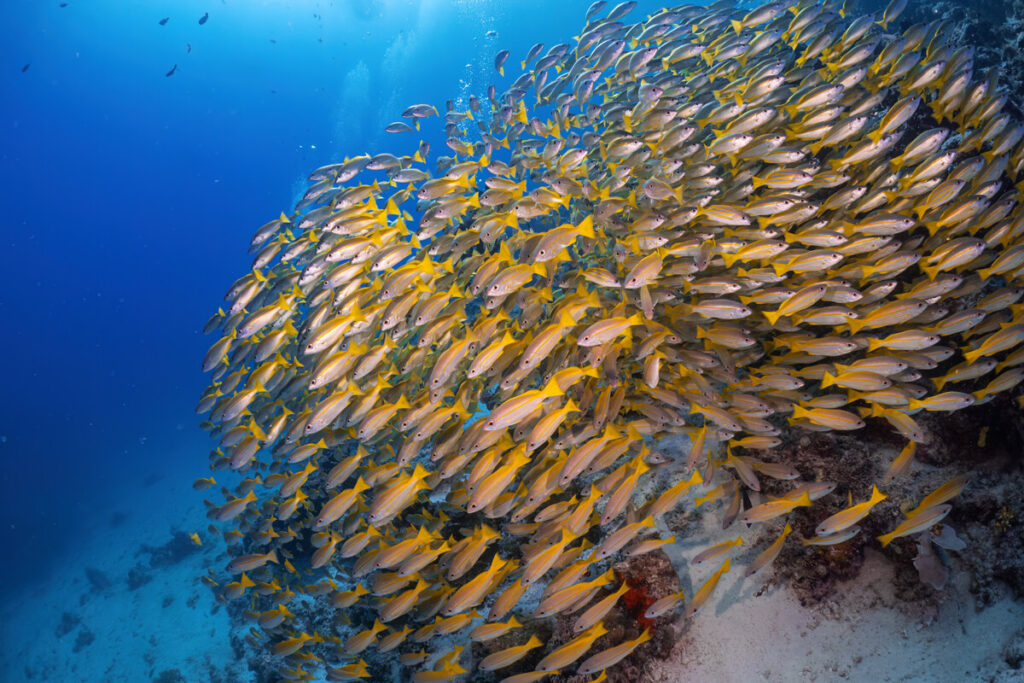
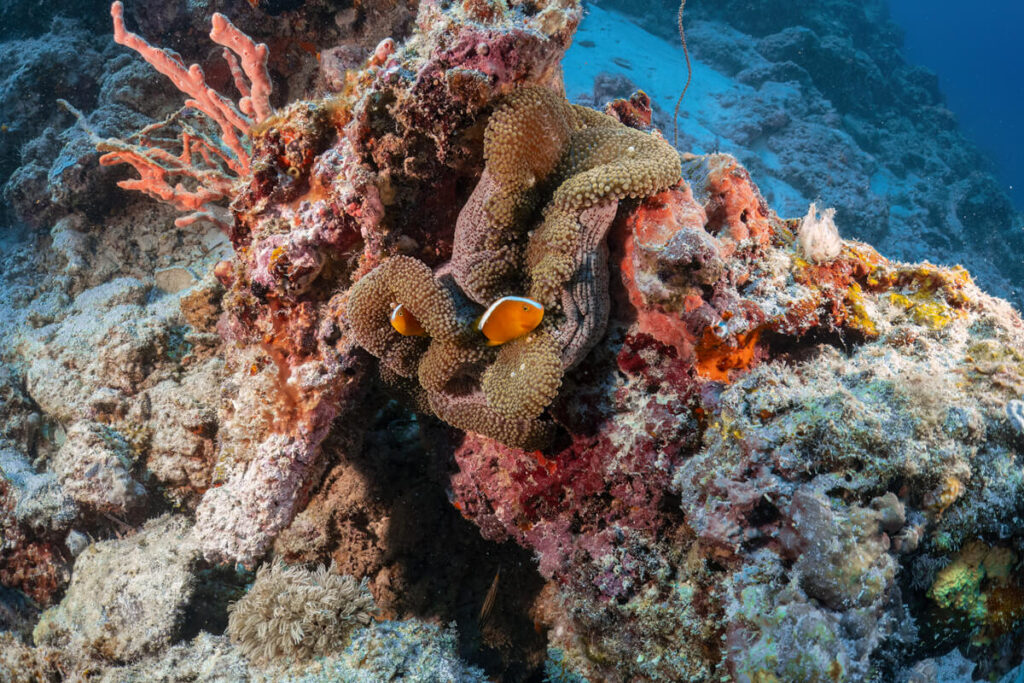
Hotel tips for Borneo
Kota Kinabalu is the perfect base for exploring the northern part of Malaysia on Borneo. The city is centrally located and offers quick access to the main attractions. From here, you can easily reach Kinabalu National Park, Kubah National Park, Tunku Abdul Rahman Marine Park, Gunung Gading National Park, and many other attractions. Excursions to the surrounding islands or the impressive mountain landscape are also easily possible.
Great hotels in Kota Kinabalu:
€ – Budget (up to €30 per night for 2 people)
- Faloe Hostel*
- Hush Inn at K Avenue Kota Kinabalu*
- Homy Seafront Hostel*
€€ – Mid-range (€30 to €80 per night for 2 people)
- Stanton City Hotel*
- Harper Boutique Hotel at Sutera Avenue*
- Hotel Sixty3*
€€€ – Luxury (€80 to €130 per night for 2 people)
- Matata Hotel Kota Kinabalu*
- Hotel Shangri-la Kota Kinabalu*
- The LUMA Hotel*
Kuching is an ideal base for exploring Sarawak’s diverse culture and nature. Many of the region’s most beautiful attractions, such as Bako National Park, the Sarawak Cultural Village, and the famous cave systems, are easily accessible from Kuching. The city itself, with its charming colonial architecture, waterfront, and markets, offers a cool ambiance to start your trip.
Great hotels in Kuching:
€ – Budget (up to €30 per night for 2 people)
- Roxy Hotel Aiman*
- Marco Polo Guest House*
- Soho Tabuan Kuching*
€€ – Mid-range (€30 to €80 per night for 2 people)
- The Ranee Boutique Suites*
- The Borneo Hotel*
- The LimeTree Hotel*
€€€ – Luxury (€80 to €130 per night for 2 people)
- The Waterfront Hotel Kuching*
- Sheraton Kuching Hotel*
- Puteri Wing – Riverside Majestic Hotel*
Transportation in Borneo – Getting from A to B
The world’s third-largest island is less densely populated than mainland Malaysia in the Malaysian states of Sabah and Sarawak. Therefore, it’s important to know the available transport options to get from one place to another without hassle.
By Air
Domestic flights are the fastest and most convenient way to travel between the capitals and larger cities in Sabah and Sarawak. Malaysia Airlines, AirAsia, and MASwings offer regular services between cities such as Kota Kinabalu, Kuching, Miri, and Sandakan. A flight from Kuching (Sarawak) to Kota Kinabalu (Sabah), for example, only takes about 1.5 hours and usually costs no more than €30 (without luggage).
By bus
Long-distance buses connect many cities and larger towns. The road infrastructure has improved, but road conditions can vary in remote areas. The route from Kuching to Sri Aman (approx. 186 km) takes about 3.5 hours by bus. You can book bus tickets here*.
By rental car
A rental car offers flexibility, especially if you want to visit remote locations or national parks. However, be aware that some roads, especially in rural areas, can be in poor condition. A 4×4 is often more suitable for such routes. Book a rental car here*.
By train
In Sabah, there is a railway line that runs from Tanjung Aru (near Kota Kinabalu) to Tenom. This scenic route is particularly popular with tourists. The “North Borneo Heritage Train” runs every Wednesday and takes you through Sabah’s beautiful natural scenery for 5 hours (book your train ticket here*). In Sarawak, however, there is currently no rail service.
By boat
In Sarawak, rivers are important transport routes, especially in remote areas. Boats and express ferries operate on rivers like the Rajang, connecting towns and villages. From Sibu, you can travel upriver to Kapit by express boat. You can also easily reach the many offshore islands by speedboat or ferry.
By taxi and rideshare
Taxis are usually always available in cities. In some areas, rideshare services like Grab are also available. However, agree on the price before the ride or make sure the meter is turned on.
Travel tips for Borneo
The best time to visit Borneo
The best time to visit Borneo in Malaysia depends on which region you want to visit and what activities you plan to do. Generally, the dry season from March to October is considered the ideal time to travel, as there is less rainfall and the weather is pleasantly warm during these months.
Especially from April to June, you can expect ideal conditions for outdoor activities such as trekking, wildlife watching, or relaxing days on the beach. July and August are also good, especially if you want to climb Mount Kinabalu.
During the rainy season from November to February, heavier rainfall is to be expected, but nature is particularly green and lush during this time. There are also fewer tourists around, which can be particularly beneficial for cultural and urban exploration. However, outdoor activities such as trekking may be limited.
If you want to go diving, the months between April and September are optimal, especially on the island of Sipadan. For wildlife lovers who want to see orangutans or turtles, the months between March and October are the best choice, as the chances of sighting them are particularly high during this time.

Entry into Borneo
The following regulations apply to entry into Borneo, the Malaysian part of the island:
- Passports must be valid for at least 6 months upon entry and contain blank pages.
- You must complete the Malaysia Digital Arrival Card (MDAC) online up to 3 days before entry.
- As a German citizen, you may stay for 90 days.
- For Sabah and Sarawak a separate visa will be issued.
- A return or onward ticket may be required upon entry.
- Proof of booked accommodation may be required upon entry.
☞ You can find a detailed article on entry here: Entering Malaysia.
Arriving in Borneo
Arriving in Borneo (the Malaysian part) is usually via international or domestic airports. There are no direct flights from Europe to Borneo. Most travelers travel via Kuala Lumpur, Singapore, or other major hubs in Southeast Asia. Airlines such as Malaysia Airlines, AirAsia, Singapore Airlines, or Scoot offer connections. There are direct connections from Singapore, Bangkok, or Jakarta to Kota Kinabalu, Kuching, or other airports on Borneo.
The Malaysian airlines AirAsia, Malaysia Airlines, and MASwings offer numerous connections between Kuala Lumpur or other cities on the Malaysian mainland and the airports in Sabah and Sarawak. Flights from Kuala Lumpur to Kota Kinabalu or Kuching take about 2–3 hours. Many destinations on Borneo, such as Sandakan (orangutan rehabilitation center), Mulu (UNESCO World Heritage Site), or Tawau (diving paradise Sipadan), are best reached by domestic flights.
There are ferry connections from Johor Bahru (Malaysia) or Pontianak (Indonesia) to Sarawak. However, these are time-consuming and more suitable for those seeking adventure. If you’re coming from the Indonesian side of Borneo (Kalimantan), you can cross the border by land or boat, for example, via the border crossing in Entikong (Sarawak).
Our tip: If you have flexible travel plans, you can often find cheap flights with AirAsia or other low-cost airlines. To get the best overview, use comparison portals like Skyscanner* or Google Flights. You can also read more about this topic here: How to book cheap flights.
Health & Vaccinations
No specific vaccinations are required for entry into Borneo. However, make sure that your standard vaccinations are up to date according to the German vaccination schedule, especially against tetanus, diphtheria, pertussis (whooping cough), measles, mumps, rubella, and polio.
The following vaccinations are recommended:
- Hepatitis A: Recommended for all travelers to Malaysia.
- Hepatitis B: Particularly useful for longer stays or close contact with the local population.
- Typhoid: For stays in rural areas or under basic hygienic conditions.
- Japanese encephalitis: For long stays in rural areas, especially during the rainy season.
- Rabies: For close contact with animals or long stays in remote areas.
In the states of Sabah and Sarawak on Borneo, there is also a medium risk of malaria. We recommend taking atovaquone/proguanil (Malarone®) or artemer/lumefantrine (Riamet®) as emergency medication. Talk to your doctor about this before your trip. How we protect ourselves from malaria.
We also recommend a well-stocked first-aid kit so that you can treat common travel illnesses and minor injuries yourself in an emergency. You should also definitely take out international health insurance. You can find out more about this here: The best travel insurance.
The tap water in Borneo is not suitable for drinking; use bottled or boiled water instead, even for brushing your teeth.
Currency & Money
The official currency in Borneo (Malaysia) is the Malaysian Ringgit (MYR). One Ringgit is divided into 100 Sen. You should carry cash with you, especially in rural areas, as card payments are often not possible there. However, in cities like Kota Kinabalu or Kuching, you will find numerous ATMs that accept international credit and debit cards (e.g., Visa or Mastercard).
When exchanging money, you should use official exchange offices or banks, as they usually offer better rates than hotels or airports. We recommend having small bills on hand, as these are often needed for markets, taxis, or smaller shops. Credit cards are mainly accepted in larger hotels, restaurants, and shopping centers. More information here: Currency Malaysia.
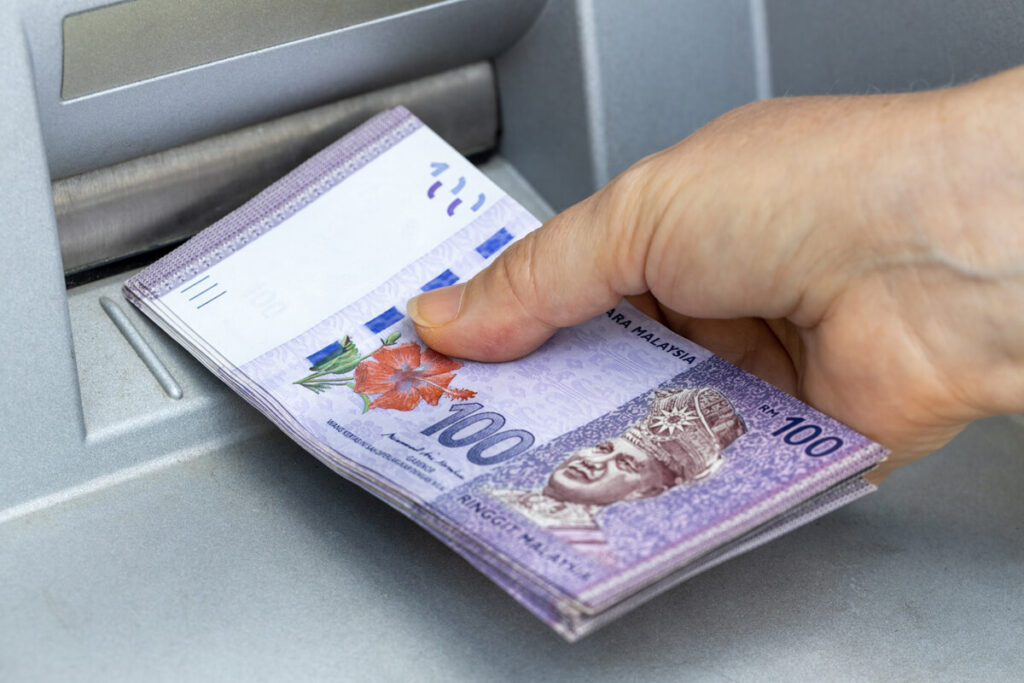
Safety in Borneo
Borneo, particularly the Malaysian states of Sabah and Sarawak, is generally considered a safe travel destination. However, as in many tourist areas around the world, caution is advised against petty crime such as pickpocketing. Thefts can occur in urban areas and tourist centers, with snatch thefts often committed by people on motorbikes.
Be especially vigilant in the eastern coastal regions of Sabah. In the past, there have been kidnappings there by criminal groups from the neighboring southern Philippines. However, the Malaysian government has implemented extensive security measures to prevent such incidents. Before traveling, inform yourself about the current security situation and, if necessary, avoid certain areas. Visit the Federal Foreign Office.
Conclusion
Borneo is a travel destination for all those who love nature and adventure. Rainforests, wild animals, and impressive landscapes await you here. You can see orangutans in their natural habitat, hike through dense forests, or relax on beautiful beaches.
The island not only has fascinating nature, but also an exciting culture and incredibly friendly people. Whether you walk through the caves of Mulu National Park, hike on Mount Kinabalu, or explore the underwater world at Pulau Sipadan, Borneo offers many unforgettable experiences.
- Kuching by Jui-Chi Chan | istock.com
- Long-nosed monkey by pwollinga | istock.com
- Mulu National Park by Wirestock | istock.com
- Orangutan by Unai Huizi Photography | shutterstock.com
- Sarawak Cultural Village by uskarp | shutterstock.com
- Kota Kinabalu with mosque of yusnizam | istock.com
- Mount Kinabalu by yusnizam | istock.com
- Mount Kinabalu by yusnizam | istock.com
- Female orangutan in the tree by Mieszko9 | istock.com
- Hammock on the beach – Gaya Island by Christian Edelmann | istock.com
- Pygmy elephants on the Kinabatangan River by davidevison | istock.com
- Small waterfall in the jungle by Craig Ansibin | istock.com
- Sea turtle by Elena Kopysova | istock.com
- Bohey Dulang Island by yusnizam | istock.com
- Colorful fish by SyncRapeephat | istock.com
- Clown fish by SyncRapeephat | istock.com
- Airplane over Kota Kinabalu by tang90246 | istock.com
- Malaysia banknote by Andrzej Rostek | istock.com